How to Set Up a VPN on a Router
Using a VPN on a router isn't as easy as it is with other devices like a phone or computer, but it's still possible in some cases. If your VPN provider supports the same router you have, here's everything you need to know to get it set up.
- By VPN Team
Using a VPN router is extremely helpful because all of your devices (phones, computers, etc.) instantly benefit from that one connection. But it's also more difficult to set up; most people have little to no experience fiddling with their router, let alone logging into it and making changes.
Only some providers let you connect through a router. It works one of two ways: a firmware file is installed on the router to enable VPN functionality, or you enter the configuration details manually into the proper section of the router's settings.
VPN Router Setup
The first step, regardless of who made your router, is to log in to it as an administrator. Most of the time, this works by accessing its web interface through a browser at 192.168.1.1, 192.168.2.1, or 192.168.0.1. When asked for a password, it's often admin by default. Check with the router manufacturer if you can't log in—they all work a little differently.
What follows also varies depending on the router you have:
ASUS | D-Link | DD-WRT | Netgear | Tomato | TP-Link
Here's what it generally looks like:
- Find the VPN section.
- Decide on a VPN protocol that your provider supports (available from their website).
- Locate the same protocol on the router and go to the "client" section.
- Enable that protocol and enter all the connection details exactly as the provider describes. This includes the server/domain/IP address, a username and password, and any other connection settings.
- Save it and use the Connect or Start button to enable the VPN.
VPNs that offer a firmware update will have you go through a process like this:
- Download the firmware file from the VPN.
- Locate the Administration or Settings area of the router.
- Find a page that mentions software or firmware.
- Upload the VPN's firmware file to replace the existing one.
- Access a custom screen to choose a server, enable and disable the VPN, and edit settings.
ASUS
These steps are for ASUS routers that are using their default firmware:
- Select VPN from the left pane.
- Open the VPN Client tab on the right.
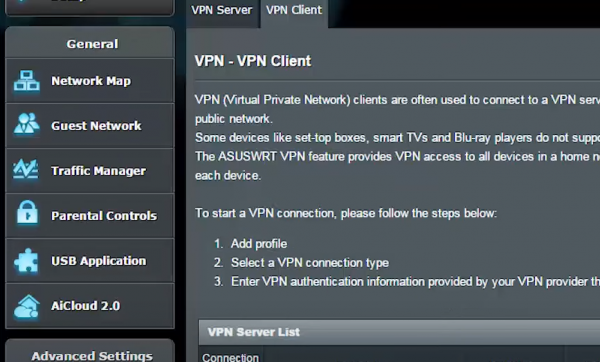
- Choose Add profile at the bottom.
- Select one of the VPN types: PPTP, L2TP, or OpenVPN.
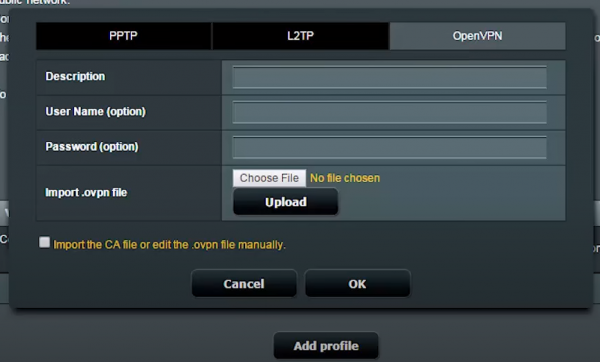
- Enter the necessary information in the fields that are provided.
- Select OK.
If you need to manually change the DNS servers on this router, those settings are in the Internet Connection area of the WAN section (left panel).
Not using stock firmware? After selecting the VPN category from the left pane, choose a tab on the right that corresponds to the VPN protocol you want to use. There might be separate tabs for PPTP/L2TP and OpenVPN. Otherwise, the steps should be pretty similar to how they're laid out above.
If the VPN provides an app, you can upload their custom firmware from the Administration > Firmware Upgrade page.
Return to step 2 and choose Activate or Deactivate next to the VPN to turn it on and off.
D-Link
Here's how to set up a VPN on a D-Link router:
- Select Settings at the top and then choose Internet from the pop-out menu.
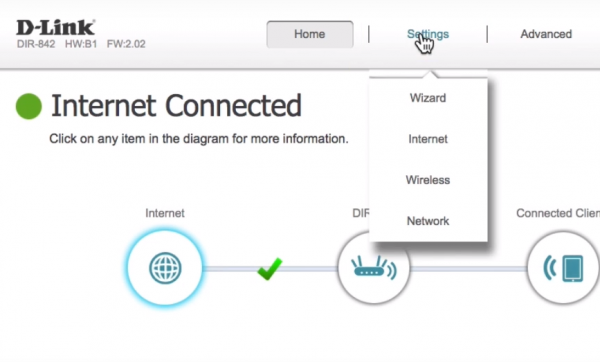
- Pick an appropriate protocol from the My Internet Connection is menu.
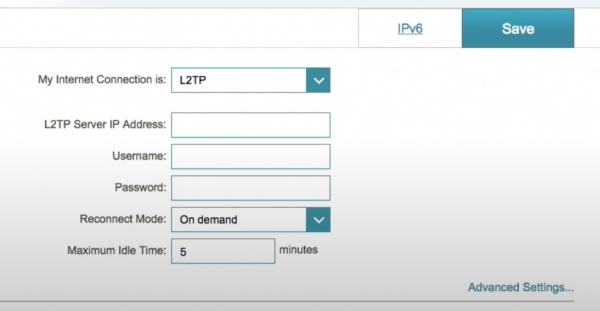
- Enter the server information into the appropriate box followed by the username and password provided by the VPN company. You might also need to adjust the idle time; check with the VPN provider to be sure.
- Select Save.
To disconnect from the server, return to step 2 but choose whatever it was before you edited the settings, probably Dynamic IP (DHCP).
Other models have the VPN settings elsewhere:
- Select Setup from the menu at the top.
- Choose PPTP or L2TP from the left pane.
- Put a check in the box next to Enable.
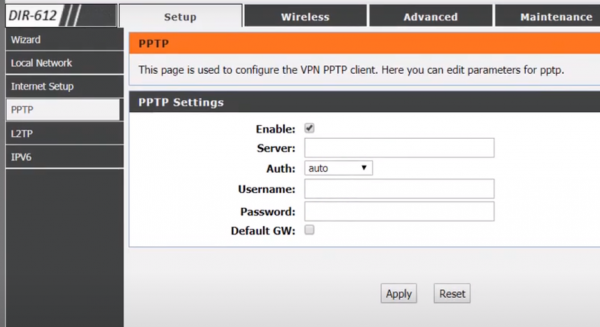
- Fill out the boxes using the connection details provided by the VPN.
- Select Apply.
Undo step 3 and choose Apply to disconnect from the VPN.
DD-WRT
If your router is running DD-WRT firmware, do this:
- Select Services at the top.
- Choose VPN in the sub-menu.
- Select the Enable option from either the PPTP Client or OpenVPN Client area.
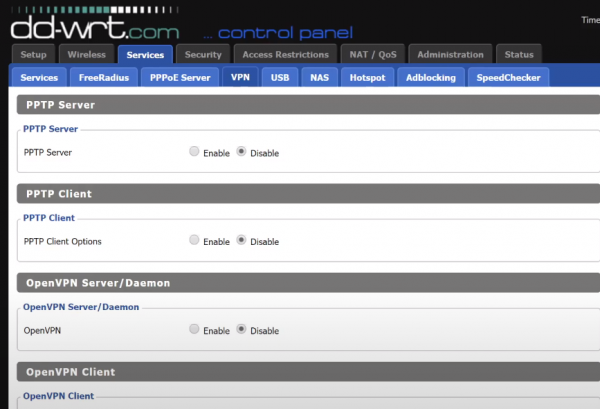
- Complete the form as necessary according to the directions from the VPN provider.
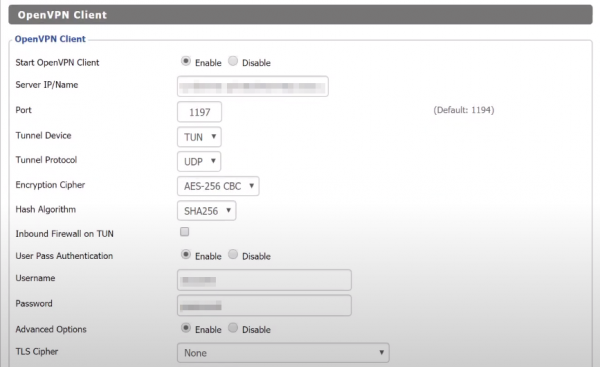
- Select Save at the bottom.
You can change the DNS settings from the Setup > Basic Setup screen.
Netgear
One way to put a VPN on a Netgear router is through custom firmware. ExpressVPN is one example of a provider that has a VPN app for routers available as a firmware file that makes setup and switching servers easy. This isn't supported on all routers, though, and neither do all VPNs offer this method.
Here's how ExpressVPN works with a Netgear Nighthawk R7000 router:
- Go to routerlogin.net and log in.
- Select Advanced at the top.
- Select Administration from the left pane, followed by Router Update in the sub-menu.
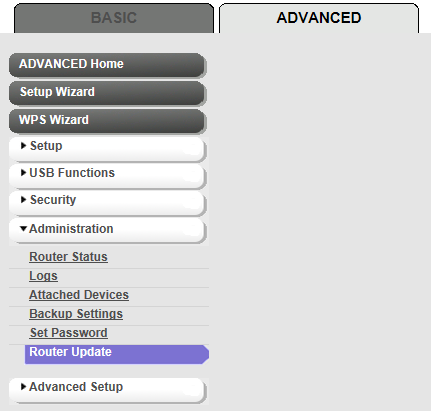
- Select Browse to locate and upload the file you downloaded from the provider.
- Choose Upload, wait for the file to upload, and then select Apply. Click through any prompts you might receive about older firmware or a temporary network disconnection.
- Wait while the firmware install completes.
- Go to expressvpnrouter.com in a new tab.
- Select Get Started and follow the directions, and then log in when asked.
- Paste the activation code from our VPN account into the box provided on the router.
- Select Activate.
Change the server you're connected to by picking one from the drop-down menu on the VPN Connection page.
To turn off the VPN, use the Disconnect button at the top of the ExpressVPNRouter.com page.
Tomato
There are several versions of the Tomato firmware out there including the original, FreshTomato, and AdvancedTomato.
Depending on what you're running, the steps should look something like this:
- Select VPN TUNNELING or VPN (the globe icon) from the left pane.
- Choose OpenVPN Client or PPTP Client from that menu.
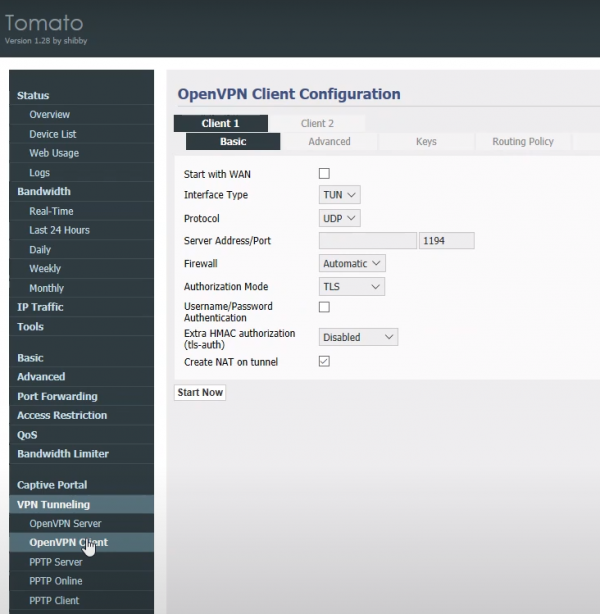
- Put a check in the box next to Start with WAN.
- Fill in the details with information from your VPN provider. In some cases, you need to check the box next to Username/Password Authentication to show those fields, and if the router has Advanced and Keys tabs, those will be used for OpenVPN.
- Select Save at the bottom.
There are sometimes several details specific to the VPN you're using that need to be entered in a very precise way. If your VPN supports routers, it should give all of this information to you.
For example, if you're using OpenVPN, you'll need to download the server file from the provider and open it with a text editor. The remote entry is the address you need to enter into the Server Address/Port field on the router.
To turn the VPN on and off, return to step 2 and choose Start Now or Stop Now.
TP-Link
Here's how to use a VPN with a TP-Link router:
- Go to tplinkwifi.net and log in.
- Use the Advanced tab at the top to select Network on the left.
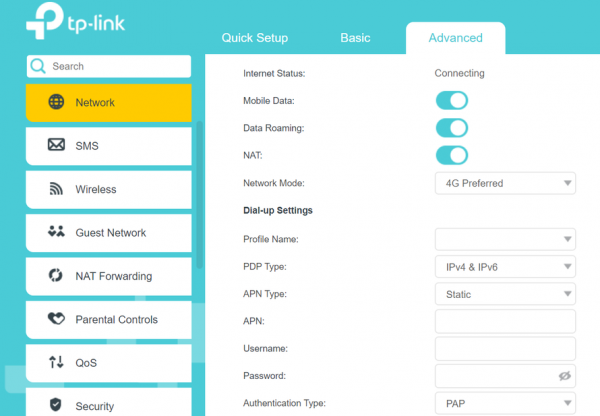
- Choose Internet from the new menu.
- Open the drop-down menu next to Internet Connection Type and choose an appropriate option, like L2TP or PPTP.
- Fill out the Username and Password fields with the login credentials provided by the VPN.
- Select Dynamic IP if it isn't already chosen.
- Paste the address of the VPN server you want to use into the VPN Server IP/Domain Name field.
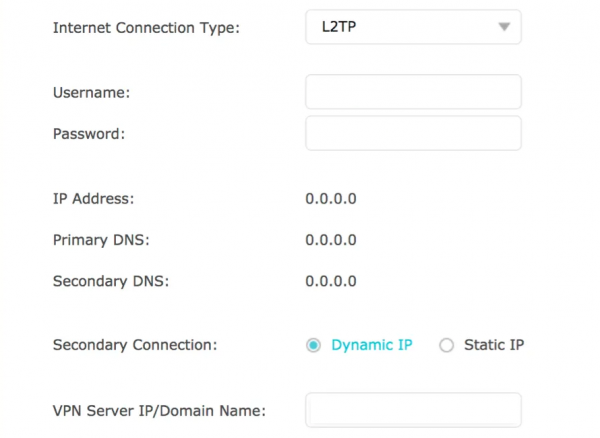
- Choose Manually for the Connection Mode option toward the bottom of the page, and change the idle time to 0.
- Save the changes.
Return to step 3 and select Connect to establish a connection to the server, or Disconnect to turn the VPN off.
Some older firmware versions work a little differently:
- Choose Network > WAN from the side panel.
- Change WAN Connection Type to L2TP/Russia L2TP or PPTP/Russia PPTP.
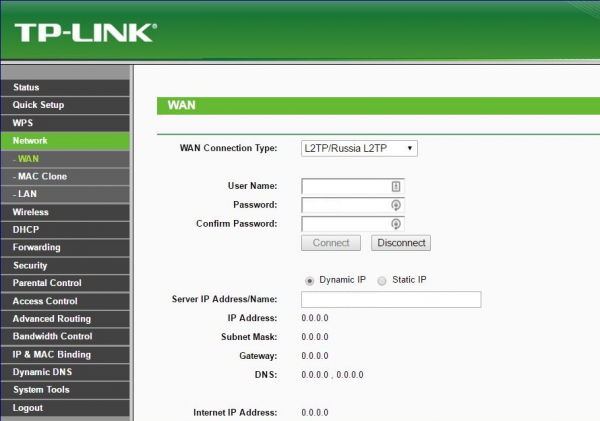
- Paste the username and password you were given by the VPN into those boxes.
- Ensure that Dynamic IP is chosen.
- Enter the VPN server into the Server IP Address/Name section.
- Edit the Max Idle Time value to be 0.
- Change the Connection Mode type to Connect Manually.
- Select Save.